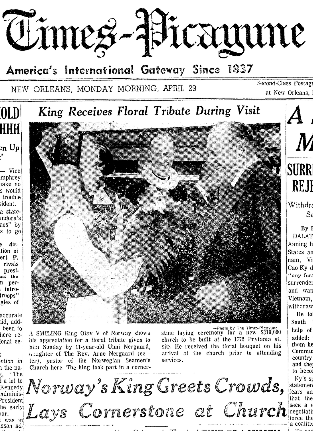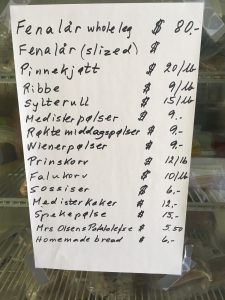
The Norwegian Seamen’s Church became the Scandinavian Jazz Church in 2017. (via Facebook)
A 20th century complex of buildings in a district revered for its 19th century architecture was given official landmark status Wednesday by the Historic District Landmarks Commission.
Designed and constructed in 1968, the Norwegian Seamen’s Church held its last service on Christmas Eve 2018. It then changed to secular hands, and its new owners are planning a wellness center.
The church’s history in the Lower Garden District began in 1906, and it is its history and cultural significance — as well as the airy Scandinavian-style mid-century architecture — that the HDLC honored in granting the extra layer of protection from alteration or demolition.
“The buildings that make up the campus more stylistically resemble Scandinavian architecture than that of the surrounding neighborhood,” HDLC staff stated in their report. “It is a valuable reminder of the diversity in culture that makes up our city.”

Scandinavian and American flags fly in front of the church in 2018. (via Orleans Parish Assessor’s Office)
When the Norwegian Seamen’s Church opened its doors, then on Magazine Street, 113 years ago, an estimated 25,000 Norwegian sailors came into the New Orleans every year and about 200 Norwegian families called New Orleans home, according to the HDLC report.
The church was part of a Norwegian mission, dating to 1864, to spread the Gospel to Nordic seamen in foreign ports. It also gave the sailors a place to read the newspapers from home, drink strong Scandinavian coffee and play some pool.
By 1928, the growing church had found a new home on Prytania and Urania streets, amid protests from neighbors who feared an influx of foreign sailors, according to newspaper reports from the time.
Before long, the small Lutheran church at 1772 Prytania was established in the New Orleans religious landscape, and its Scandinavian holidays, concerts and pageants were regularly described in local newspapers. In 1942, a photo on The Times-Picayune’s front page showed the church’s pastor, the Rev. Johan Iverson, along with the local Norwegian consul and vice consul, toasting a photo of Norway’s King Haakon VII on the monarch’s 70th birthday.
With Scandinavian vessels dominating the port, the church had outgrown its two-story Greek Revival building on Prytania. After years of fundraising, it began driving piles at the end of 1967 for the $340,000 L-shaped church and recreation center. The brick complex included the one-story church and a two-story recreation building with a reading room, game room, TV room, kitchen and offices.
“We are doing our best to provide good solid religious and recreational services for the seamen to keep them out of undesirable places,” Norwegian consul Harald Werner, the church’s chairman, told a reporter.

King Olaf V of Norway visited New Orleans in 1968 to help lay the cornerstone of the Norwegian Seamen’s Church on Prytania.
In 1968, New Orleans welcomed King Olaf V, who came to town for the church’s cornerstone-laying ceremony. The pastor and other dignitaries could toast Haakon’s son in person, rather than a mere photograph.
At Olaf’s side while during the ceremony was the project’s architect Nils Erling Hansen, a New Orleanian of Norwegian heritage.
Jazz became an integral part of the church not long after the church moved into its modern buildings. Church historians say the first jazz musician to play was the church’s mailman, Narvin Kimball, who retired from the post office in 1973 and played banjo and string bass with the Preservation Hall Jazz Band until 1999.
By the late 1970s, the church was hosting jazz concerts in the dining room and by the swimming pool and conducting a jazz service the first Sunday of each month. Among the musicians it hosted are Uncle Lionel Batiste, Gregg Stafford, Seva Venet, Danny Barker and Dr. Michael White. It became known as jazzkirken, the jazz church.
It formally took on the name Scandinavian Jazz Church after it lost its funding from the Norwegian government in 2016.
The missionary arm of the Church of Norway was shedding its U.S. churches, reducing the number from a peak of 30 to only six, the Daily Scandinavian reported in 2017. A story in the Norwegian American noted that, though plenty of Scandinavian flags can still be found in the Port of the New Orleans, the seamen on those ships are likely to be from nations such as the Philippines and Sri Lanka.

A small grocery in the cultural center sold Scandinavian foods. (Uptown Messenger)
As the threat of closure loomed, a local group formed to save the church, raising money to buy the building from the Church of Norway and rebranding it the Scandinavian Jazz Church and Cultural Center, with an expanded reach and purpose. But the enterprise was not financially sustainable, and last year it held its last Christmas festival in November, its last Santa Lucia Celebration in December and its last jazz service.
The church’s Lower Garden District neighbors suggested that the complex be honored with landmark status, although it already receives protection as part of a historic district. At the property owner’s request, the landmark designation does not extend to a dormitory and garage on the Urania Street side.
Some of the neighbors want the additional protection for the dormitories and garage, said to be built between 1971 and 1994 and renovated in 2014.
“The original structure with renovations were designed by a Norwegian architect to blend perfectly with the mid-century modern aesthetic of the campus,” Evan Benton, who lives on Urania, told the HDLC. “It has always hosted more secular functions than a typical chruch. The dormitory structure is essential to these functions.”
The commissioners voted unanimously to give the complex landmark status, with the exception of the dormitory and garage, as a symbol of New Orleans’ role as an international port.

Only the buildings, not the pool, are granted landmark status. (via www.jazzchurch.us)